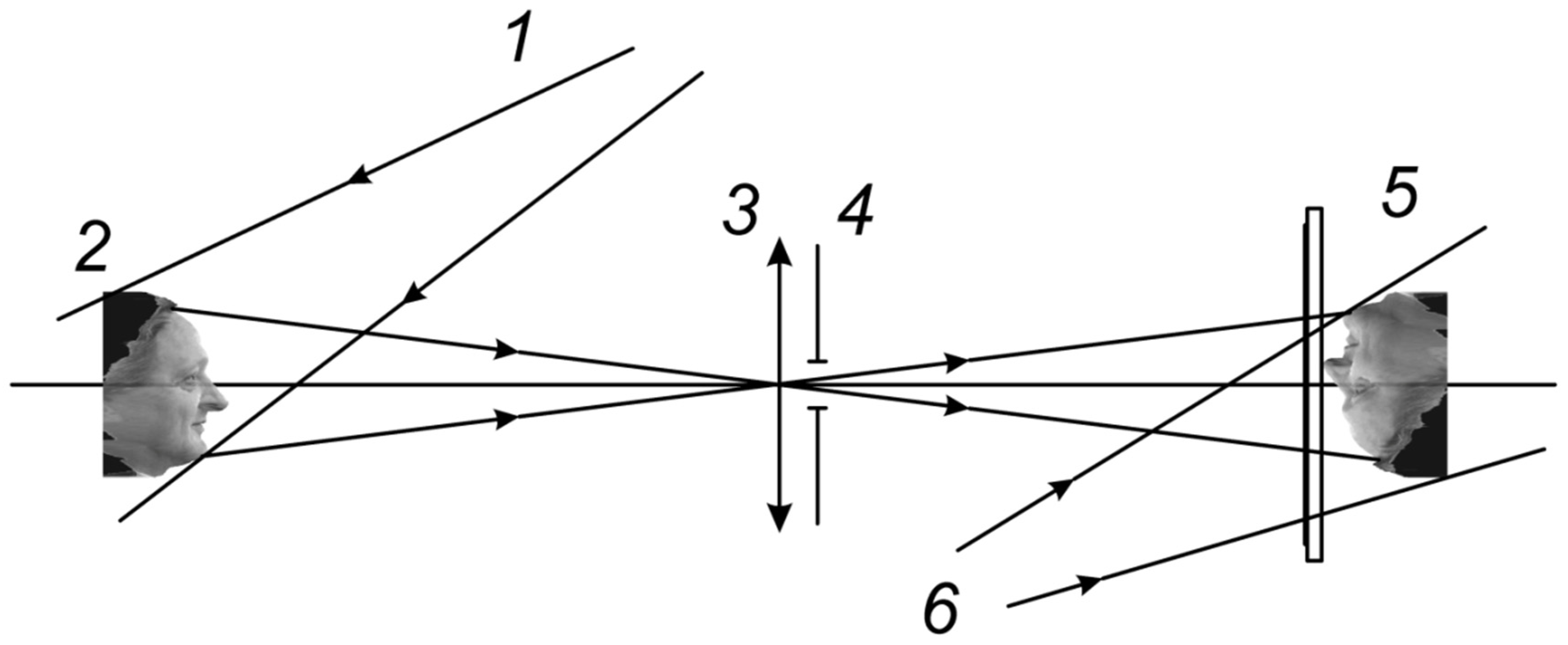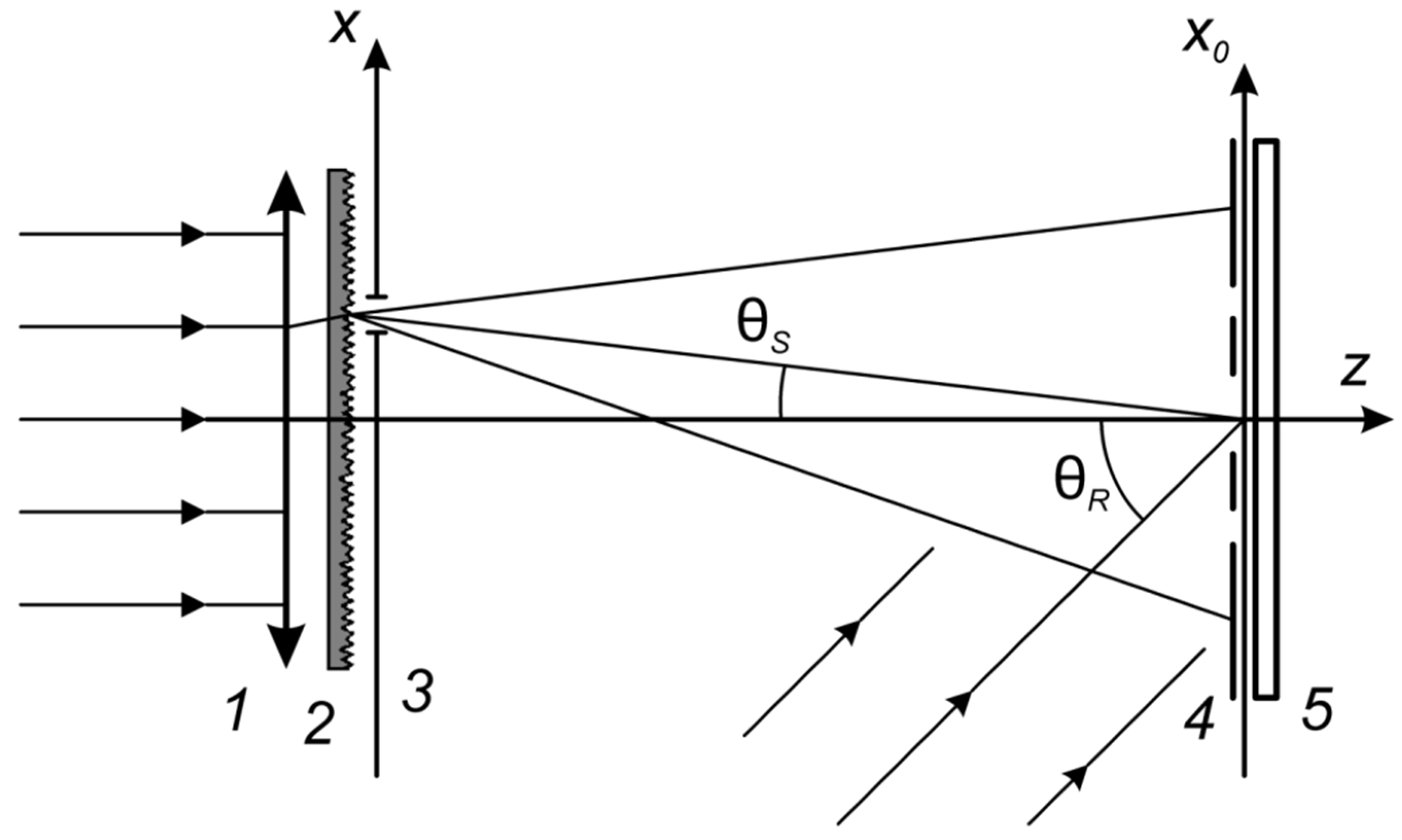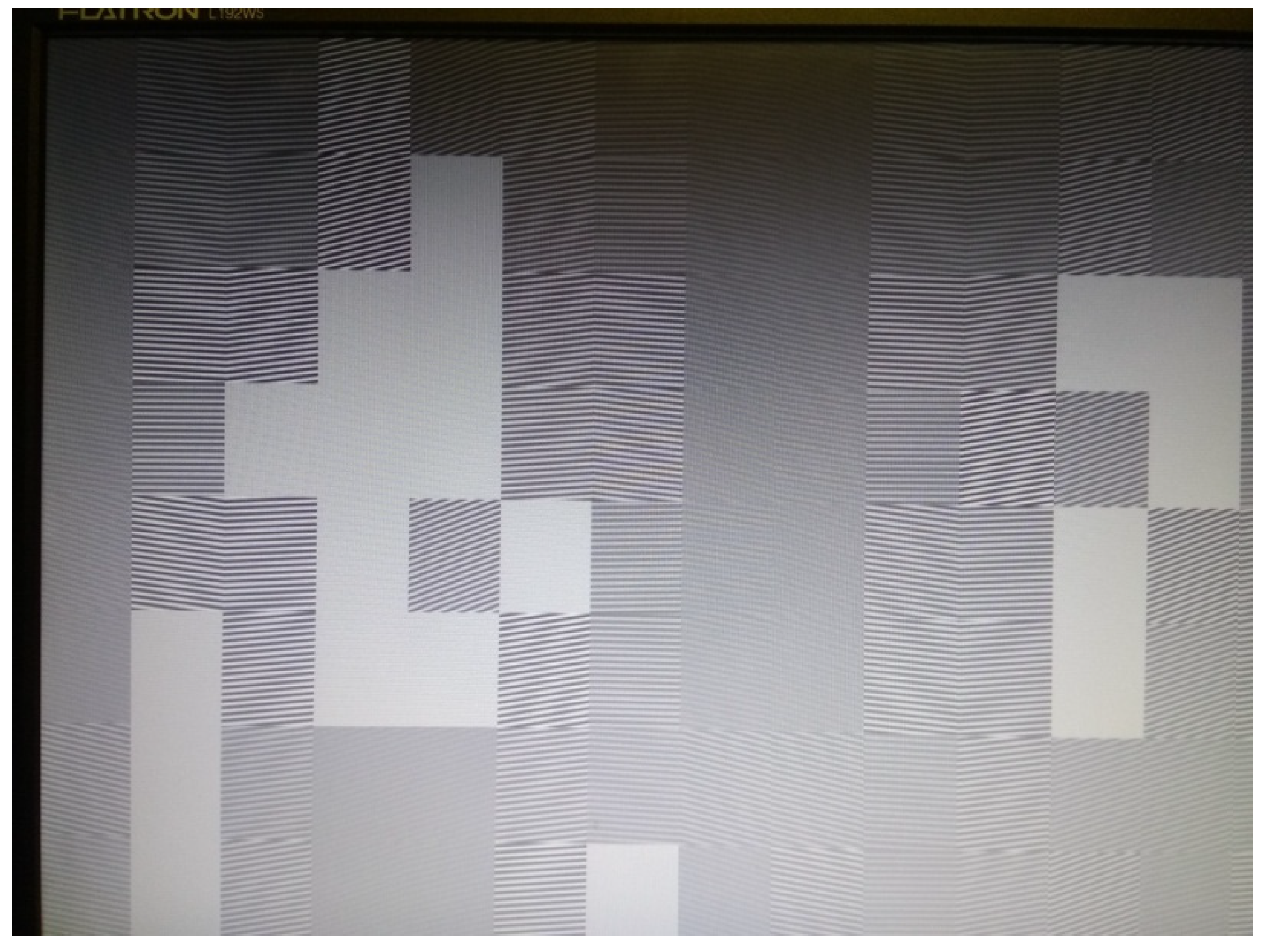Recording a Hologram Transmitted over a Communication Channel on One Sideband
Abstract
:1. Introduction
2. Experimental Recording of a Rainbow Hologram at the Receiving End of the Communication Channel
3. Results and Discussion
4. Conclusions
Supplementary Materials
Author Contributions
Funding
Institutional Review Board Statement
Informed Consent Statement
Data Availability Statement
Acknowledgments
Conflicts of Interest
References
- Ebrahimi, T.; Foessel, S.; Pereira, F.; Schelkens, P. JPEG Pleno: Toward an Efficient Representation of Visual Reality. IEEE MultiMedia 2016, 23, 14–20. [Google Scholar] [CrossRef]
- Schelkens, P.; Ebrahimi, T.; Gilles, A.; Gioia, P.; Oh, K.-J.; Pereira, F.; Perra, C.; Pinheiro, A.M.G. JPEG Pleno: Providing representation interoperability for holographic applications and devices. ETRI J. 2019, 41, 93–108. [Google Scholar] [CrossRef] [Green Version]
- Muhamad, R.K.; Birnbaum, T.; Gilles, A.; Mahmoudpour, S.; Oh, K.-J.; Pereira, M.; Perra, C.; Pinheiro, A.; Schelkens, P. JPEG Pleno holography: Scope and technology validation procedures. Appl. Opt. 2021, 60, 641–651. [Google Scholar] [CrossRef] [PubMed]
- ISO/IEC 21794. In Information Technology—Plenoptic Image Coding System (JPEG Pleno); ISO/IEC: Geneva, Switzerland, 2020.
- Schelkens, P.; Astola, P.; da Silva, E.A.B.; Pagliari, C.; Perra, C.; Tabus, I.; Watanabe, O. JPEG Pleno light field coding technologies. In Applications of Digital Image Processing XLII; SPIE Optical Engineering + Applications: San Diego, CA, USA, 2019; Volume 11137, p. 111371G. [Google Scholar] [CrossRef]
- Thanou, D.; Chou, P.A.; Frossard, P. Graph-Based Compression of Dynamic 3D Point Cloud Sequences. IEEE Trans. Image Process. 2016, 25, 1765–1778. [Google Scholar] [CrossRef] [PubMed] [Green Version]
- Liu, M.; Zhao, J.; Guo, X.; Zhuang, R. Application of Improved Point Cloud Streamlining Algorithm in Point Cloud Registration. In Proceedings of the 2020 Chinese Control and Decision Conference (CCDC), IEEE, Hefei, China, 22–24 August 2020; pp. 4824–4828. [Google Scholar] [CrossRef]
- Botsch, M.; Pauly, M.; Kobbelt, L.; Alliez, P.; Lévy, B.; Bischoff, S.; Rössl, C. Geometric modeling based on polygonal meshes. In ACM SIGGRAPH 2007 Courses; Association for Computing Machinery: San Diego, CA, USA, 2007. [Google Scholar] [CrossRef] [Green Version]
- Nasri, A.H. Constructing polygonal complexes with shape handles for curve interpolation by subdivision surfaces. Comput.-Aided Des. 2001, 33, 753–765. [Google Scholar] [CrossRef]
- Lee, S.; Hong, H.; Eem, C. Voxel-Based Scene Representation for Camera Pose Estimation of a Single RGB Image. Appl. Sci. 2020, 10, 8866. [Google Scholar] [CrossRef]
- Huang, M.; Wei, P.; Liu, X. An Efficient Encoding Voxel-Based Segmentation (EVBS) Algorithm Based on Fast Adjacent Voxel Search for Point Cloud Plane Segmentation. Remote Sens. 2019, 11, 2727. [Google Scholar] [CrossRef] [Green Version]
- Titar, V.P.; Bogdanova, T.V. Issues in creating holographic television system. Radioelectron. Inf. 1999, 2, 38–42. [Google Scholar]
- Denisyuk, Y.N. Are the fundamental principles of holography well-known enough for creating new types of three-dimensional films and artificial intelligence? Tech. Phys. 1991, 61, 149–161. [Google Scholar]
- Shoydin, S.A. Synthesis of holograms received by a communication channel. Comput. Opt. 2020, 44, 547–551. [Google Scholar] [CrossRef]
- Shoydin, S.A.; Pazoev, A.L. Method of holographic recording remote formation. Avtometriya 2021, 1, 92–102. [Google Scholar] [CrossRef]
- Shoydin, S.A. Method of Holographic Recording Remote Formation. Patent RF No. 2707582, 28 November 2019. [Google Scholar]
- Pazoev, A.L.; Shoydin, S.A. Transmission of holographic information on a single sideband. In Collection of Materials of the National Conference with International Participation “SibOptika-2021”. Section 2: Optical and Optoelectronic Instrumentation; SSUGT: Novosibirsk, Russia, 2021; Volume 8, pp. 109–117. [Google Scholar] [CrossRef]
- Denisyuk, Y.N. On reflecting optical properties of an object in the wave field of radiation scattered by this object. Proc. USSR Acad. Sci. 1962, 144, 1275–1278. [Google Scholar]
- Shoydin, S.A.; Pazoev, A.L. Features of the synthesis of SSB holograms (SSBH). In Proceedings of the HOLOEXPO 2021: XVIII International Conference on Holography and Applied Optical Technology, Moscow, Russia, 21–22 September 2021. [Google Scholar]
- Goodman, J.W. Introduction to Fourier Optics; Mir Publishers: Moscow, Russia, 1970; 364p. [Google Scholar]
- Stroke, G.W. White-light reconstruction of holographic images using transmission holograms recorded with conventionally-focused images and “in-line” background. Phys. Lett. 1966, 23, 325–327. [Google Scholar] [CrossRef] [Green Version]
- Benton, S.A. Hologram reconstruction with extended incoherent sources. J. Opt. Soc. Am. 1969, 59, 1545–1547. [Google Scholar]
- Shoydin, S.A.; Pazoev, A.L. Remote Formation of Holographic Record. Optoelectron. Instrum. Data Process. 2021, 57, 80–88. [Google Scholar] [CrossRef]
- Aleshin, B.S.; Bondarenko, A.V.; Vlasov, N.G.; Nikolaev, V.N.; Tsibul’kin, M.L. Process of Generation of Iridescent Holo-Graphic Images. Patent RF No. 2168197, 27 May 2001. [Google Scholar]
- Ryabukho, V.P. Rainbow holograms. Phys. Educ. High. Sch. 2003, 9, 88–99. [Google Scholar]
- St-Hilaire, P.; Benton, S.A.; Lucente, M.E.; Hubel, P.M. Color images with the MIT holographic video display. In Practical Holography VI; SPIE/IS&T 1992 Symposium on Electronic Imaging; Science and Technology: San Jose, CA, USA, 1992; Volume 1667. [Google Scholar] [CrossRef] [Green Version]
- Son, J.; Lee, H.; Lee, B.; Lee, K. Holographic and Light-Field Imaging as Future 3-D Displays. Proc. IEEE 2017, 105, 789–804. [Google Scholar] [CrossRef]
- Lucente, M. The First 20 Years of Holographic Video—And the Next 20. In Proceedings of the SMPTE 2nd Annual International Conference on Stereoscopic 3D for Media and Entertainment, New York, NY, USA, 21–22 June 2011; Available online: https://www.researchgate.net/publication/268387890 (accessed on 25 November 2021).
- Mikhailov, V.P.; Kreines, V.M.; Sarnadskii, V.N.; Vilberger, S.Y.; Fedorov, Y.S. Method for Detecting Postural Disbalance. Patent RF No. 2136209, 10 September 1999. [Google Scholar]
- Shoydin, S.A. Modeling of diffraction on volumetric bodies in the MatLab software environment. In INTEREXPO GEO-Sibir-2012; SSUGT: Novosibirsk, Russia, 2012; Volume 1, pp. 171–174. Available online: https://elibrary.ru/item.asp?id=17965012 (accessed on 25 November 2021).
- Yanagihara, H.; Kakue, T.; Yamamoto, Y.; Shimobaba, T.; Ito, T. Real-time three-dimensional video reconstruction of real scenes with deep depth using electro-holographic display system. Opt. Express 2019, 27, 15662–15678. [Google Scholar] [CrossRef] [PubMed]











| Main Stages | Title of Main Publication | Publication of the Basic Content | |
| 1. | Mapping of the patient’s body surface with structured light. | Mikhailov V. P. & Co. Method for detecting postural disbalance (Computer optical topography). | [29] |
| 2. | The problem is formulated of model 3D holographic signals for the purpose of their dynamic transmission. | Shoydin S. A. & Co. Modeling of diffraction on volumetric bodies in the MatLab software environment. | [30] |
| 3. | A method to record 3D holographic information suitable for transmission along conventional radio channels is chosen. | Shoydin S. A. Method of holographic recording remote formation. | [16] |
| 4. | A holographic system is proposed for registering 3D information by another method, using a ToF camera with surface sensing, followed by the formation of a point cloud, with the ability to create 3D images with a frame frequency of 20 Hz and low resolution in the depth of the object. | Yanagihara H. & Co. Real-time three-dimensional video reconstruction of real scenes with deep depth using electro-holographic display system. | [31] |
| 5. | The possibility to transmit 3D holographic information over a conventional communication channel and its main features are described. | Shoydin S. A. & Co. Synthesis of holograms received by a communication channel. | [14] |
| 6. | The transmission of a 3D holographic signal of Full HD standard with TV frame rate is performed experimentally. | Pasoev A. L. & Co. Transmission of holographic information on a single sideband. | [17] |
| 7. | A hologram has been experimentally recorded from 3D information transmitted over a conventional radio channel. | Shoydin S. A. & Co. Recording a hologram transmitted over a communication channel on one sideband. | Present paper |
Publisher’s Note: MDPI stays neutral with regard to jurisdictional claims in published maps and institutional affiliations. |
© 2021 by the authors. Licensee MDPI, Basel, Switzerland. This article is an open access article distributed under the terms and conditions of the Creative Commons Attribution (CC BY) license (https://creativecommons.org/licenses/by/4.0/).
Share and Cite
Shoydin, S.A.; Odinokov, S.B.; Pazoev, A.L.; Tsyganov, I.K.; Drozdova, E.A. Recording a Hologram Transmitted over a Communication Channel on One Sideband. Appl. Sci. 2021, 11, 11468. https://doi.org/10.3390/app112311468
Shoydin SA, Odinokov SB, Pazoev AL, Tsyganov IK, Drozdova EA. Recording a Hologram Transmitted over a Communication Channel on One Sideband. Applied Sciences. 2021; 11(23):11468. https://doi.org/10.3390/app112311468
Chicago/Turabian StyleShoydin, Sergey A., Sergey B. Odinokov, Artem L. Pazoev, Ivan K. Tsyganov, and Ekaterina A. Drozdova. 2021. "Recording a Hologram Transmitted over a Communication Channel on One Sideband" Applied Sciences 11, no. 23: 11468. https://doi.org/10.3390/app112311468






